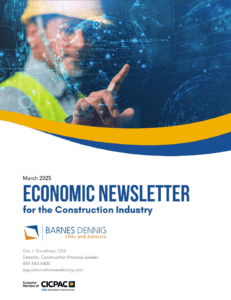CICPAC Construction Industry Economic Outlook
Published on by Eric Goodman in Construction

As the construction industry navigates a pivotal period of transition, the March 2025 CICPAC Economic Newsletter provides timely insights into the trends, risks, and opportunities shaping the landscape. From shifting government policies and fickle material prices to regional growth pockets and evolving credit markets, the sector is balancing short-term challenges with long-term potential.
This summary distills several key takeaways from the report to help you stay informed and ready to act in a volatile economic environment.
Key takeaways from the newsletter
The U.S. economy is experiencing uneven growth, with Q1 GDP effectively flatlining at 0.4%–0.8% once adjusted for an unusual spike in gold imports. Government spending cuts are at the forefront of fiscal strategy, aiming to reduce debt burdens amid a concerning debt-to-GDP ratio of 122%. These adjustments, combined with ongoing tariff negotiations, inject near-term volatility into the market. Meanwhile, the Federal Reserve’s easing path continues, with interest rates expected to drift toward a target of 3.0% by 2026, although borrowing costs remain elevated due to Treasury rate pressures.

In construction, non-residential activity remains a bright spot, growing at 3.4% year-over-year, largely propelled by manufacturing investments and reshoring efforts. Infrastructure projects, fueled by prior federal funding, continue to sustain elevated spending levels. Residential construction, however, shows signs of plateauing. Activity is stabilizing around 1.4 million units, with higher mortgage rates and anticipated increases in unemployment placing a damper on growth. Permitting activity has softened, though easing bond yields may bring some relief by mid-year.
Material costs present a mixed picture. Copper prices have surged 26.3% year-to-date, while steel remains subdued despite new tariffs. Supply chain constraints, driven by preemptive stockpiling ahead of tariff deadlines, have pushed freight rates higher—particularly in the trucking sector, where rates are up roughly 7% year-over-year.
Labor market conditions are easing moderately, with construction wage growth cooling to 2.8% in late 2024. However, persistent worker shortages in skilled trades and manufacturing continue to pose challenges. Credit conditions are improving, with business sentiment on the upswing as banks begin to loosen lending standards. The ABA Business Credit Index rose sharply to 56.9, signaling optimism for improved financing availability over the next six months.
Regionally, growth hotspots such as Dallas-Fort Worth, Houston, Salt Lake City, and Phoenix are leading the charge in construction activity. Conversely, areas heavily reliant on government employment may face localized slowdowns as public sector job cuts ripple through their economies.
For deeper insights, regional data, and sector-by-sector analysis, download the full March 2025 Construction Industry Economic Newsletter. Questions about what is covered in the report, and it might impact your company? Contact a member of our Construction team for a no-cost consultation.
